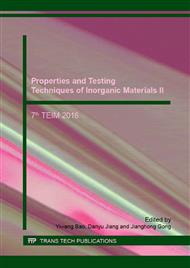p.23
p.28
p.33
p.38
p.43
p.50
p.55
p.60
p.65
Determination of Phthalate Esters in Plastic Track Surface Layer Material by Gas Chromatography
Abstract:
A method was proposed to simultaneously and rapidly determine the content of five kinds of phthalate esters (DMP, DBP, BBP, DnHP, DOP) in plastic track surface layer material by gas chromatography (GC) with the external standard,and the method was first proposed. The sample pretreatment method was microwave-assisted extracted using ethyl acetate as the solvent. Discussed the effects of extraction conditions on the extraction efficiency, microwave extraction time was 30 minutes, microwave extraction temperature was 100°C,the volume of ethyl acetate was 15mL. The results showed that there was a good linear relationship in range of 0.040 to 50 mg/L(R2 was 0.9987-0.9994). The average recoveries of standard addition for five kinds of phthalate esters were between 83.83% and 101.02%, and the relative standard derivations (RSDs (n=6)) ranged from 0.95% to 4.73%. The three times of signal to noise ratio (3 S/N) was used to calculate the detection limit of the method , and the detection limit was 2.5-3.0 mg/kg. The ten times of signal to noise ratio (10 S/N) was used to calculate the quantitation limit of the method, and the limit of quantitation was 8.5-10 mg/kg. This method is simple, effective and suitable for the determination of phthalate esters in plastic track surface layer material.
Info:
Periodical:
Pages:
43-49
Citation:
Online since:
January 2017
Authors:
Price:
Сopyright:
© 2017 Trans Tech Publications Ltd. All Rights Reserved
Share:
Citation:


